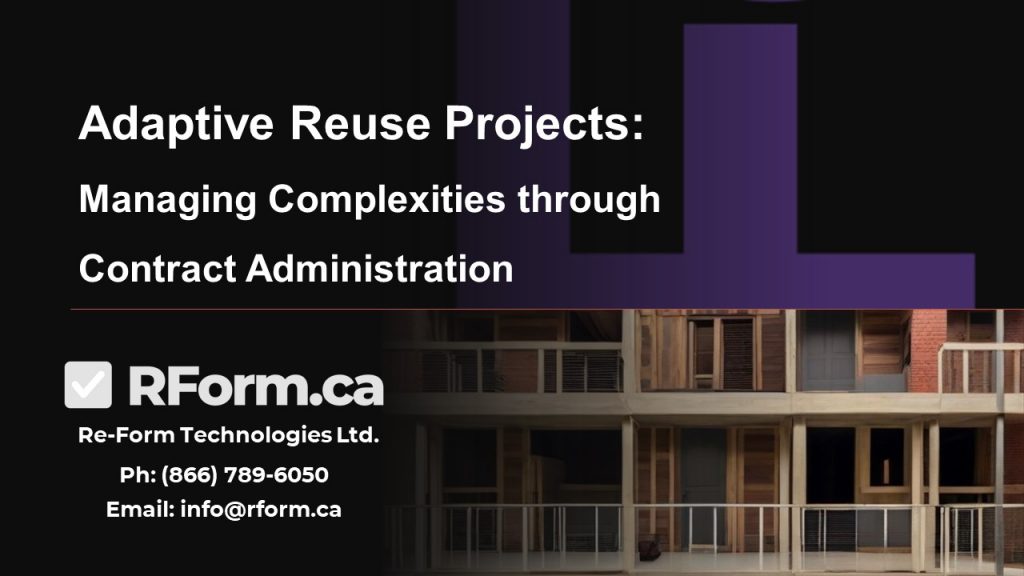
The Canadian National Housing Strategy Act is a sign of change, and nowhere is this more evident than in the growing trend of adaptive reuse projects. These projects involve repurposing existing structures for new uses and blending the old with the new.
In a recent Architizer article, Architectural Drawings: 7 Ingenious Examples of Adaptive Reuse in Section (https://architizer.com/blog/inspiration/collections/drawings-adaptive-reuse/), author Eric Baldwin states: “The best illustrations tell powerful stories of how we experience design. In section drawings, architects can understand how light, structure, and scale shape how people move through rooms and gather. Today, adaptive reuse projects are rising as the understanding of embodied energy grows. The following projects showcase section drawings of adaptive reuse projects at various scales. Together, they represent a dialogue between history and innovation.”
Architizer’s examples demonstrate the elegance of adaptive reuse, but these projects can also pose unique logistical and regulatory challenges. Commonly adaptive reuse projects often have long timelines, along with factors that can contribute to delays:
- Unforeseen Conditions: Older buildings often harbor surprises:
- Structural Issues: Hidden damage, outdated construction methods, or deterioration of materials may necessitate extensive repairs or reinforcement.
- Hazardous Materials: Asbestos, lead paint, or other contaminants require specialized removal and safe disposal, slowing down the process.
- Unexpected Discoveries: Historical elements might emerge during demolition, requiring preservation efforts and potential project redesigns.
- Complex Approvals and Permitting:
- Zoning and Regulations: Adaptive reuse may involve navigating complex zoning restrictions, especially if a building’s use is significantly altered.
- Historical Preservation: Projects involving historical buildings might require additional reviews and approvals from preservation boards, extending the timeline.
- Community Input: Depending on the project’s scale, community consultations and feedback can take time, impacting deadlines.
- Design and Planning Challenges:
- Balancing Old and New: Marrying historical features with modern uses and building code compliance demands meticulous planning and creative solutions.
- Unforeseen Site Conditions: Existing infrastructure (plumbing, electrical) might be unsuitable for the new purpose, requiring extensive redesign.
- Construction Complexities:
- Specialized Skills: Working with older structures often requires tradespeople with expertise in heritage restoration techniques.
- Phasing and Coordination: Adaptive reuse might involve working in phases around existing occupants or sensitive areas within the building, increasing project duration.
- Funding and Financing:
- Securing Funding: Adaptive reuse projects may require specialized financing or incentives, adding time to secure the necessary funds.
- Budget Overruns: Unforeseen conditions and design changes can lead to cost increases, potentially requiring additional fundraising efforts.
While these challenges are common, careful planning, collaboration with historic preservation experts, and utilizing tools to manage projects effectively can help mitigate delays. Tools like RForm Contract Administration Software are invaluable for architects facing these hurdles. For instance, RForm can streamline obtaining necessary permits and approvals for adaptive reuse projects, reducing the time and effort required. By simplifying the administrative side of projects, architects can focus on the creative dialogue between the past and the future and ensure their visions align with initiatives like the National Housing Strategy Act.
RForm Contract Administration Software simplifies the complexity of blending past and present, ensuring that these projects are not just a nod to history but a step forward in building a sustainable, inclusive future. As the National Housing Strategy Act continues to shape the housing landscape, tools like RForm are indispensable allies for architects and developers, turning challenges into triumphs.
- Streamlined Communication: Adaptive reuse projects involve many stakeholders, including heritage committees, urban planners, engineers, and construction teams. RForm provides a unified platform for seamless communication, ensuring everyone knows the latest developments.
- Document Control: With paperwork, such as permits, design plans, and compliance documents, keeping track of everything can feel like herding cats. RForm offers robust document management features that act as a digital filing cabinet, always organized and uncluttered.
- Versatility in Management: Whether an old warehouse is turned into loft apartments or a historic church is finding new life as a community center, each adaptive reuse project has its unique cadence. RForm adapts to each project’s diverse needs, providing customizability as essential as a building’s foundation.
The act’s emphasis on sustainability and inclusivity is pivotal in adaptive reuse projects. RForm aligns with these values, offering tools to help architects and developers track and meet green building standards and accessibility requirements. This partnership respects the past and paves the way for an inclusive future.
Benefits of Utilizing RForm for Time and Cost Optimization:
- Efficiency: Time is of the essence, and budgets are not a limitless resource pool. RForm helps keep projects on track, minimizing delays and budget overruns through proactive contract administration.
- Transparency: The clear, accountable processes facilitated by RForm foster trust among stakeholders, often leading to smoother approvals and fewer conflicts.
- Compliance: With constant regulation updates, staying compliant can be a moving target. RForm’s features ensure that every i is dotted and every t is crossed regarding regulatory adherence.
Adaptive reuse projects require exquisite coordination to balance historical preservation and modern standards. This task is not for the faint-hearted; it demands a meticulous approach to contract administration. RForm emerges in this domain, conducting the contractual documentation precisely and easily.
Our most recent RForm Bulletin 24-0303 focuses on the long project timelines that are a significant hurdle in addressing the housing shortage. The relationship between the time it takes to build and the availability of homes is a delicate dance of resources, regulations, and workforce. By exploring the factors that contribute to these extended timelines, from securing permits to the intricacies of resource allocation and scheduling, we aim to shed light on how these challenges contribute to the scarcity of housing and what might be done to mitigate these issues, thus contributing to a solution for the Canadian housing crisis.
The RForm Advantage: RForm’s Contract Administration software is valuable for project managers looking to streamline their processes, mitigate risks, and ensure successful project outcomes. RForm enables project managers to focus on strategic decision-making and client relationships by automating and centralizing contract-related tasks.

